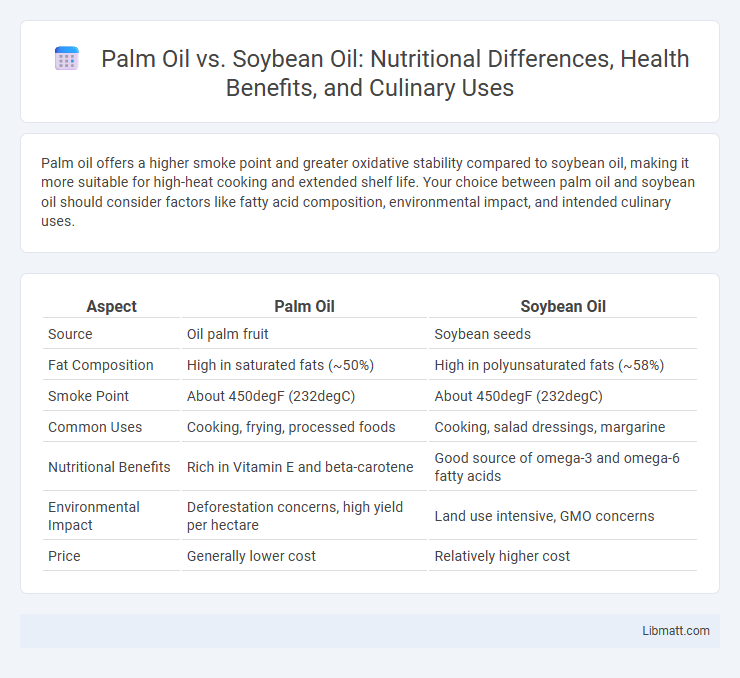Palm oil offers a higher smoke point and greater oxidative stability compared to soybean oil, making it more suitable for high-heat cooking and extended shelf life. Your choice between palm oil and soybean oil should consider factors like fatty acid composition, environmental impact, and intended culinary uses.
Table of Comparison
| Aspect | Palm Oil | Soybean Oil |
|---|---|---|
| Source | Oil palm fruit | Soybean seeds |
| Fat Composition | High in saturated fats (~50%) | High in polyunsaturated fats (~58%) |
| Smoke Point | About 450degF (232degC) | About 450degF (232degC) |
| Common Uses | Cooking, frying, processed foods | Cooking, salad dressings, margarine |
| Nutritional Benefits | Rich in Vitamin E and beta-carotene | Good source of omega-3 and omega-6 fatty acids |
| Environmental Impact | Deforestation concerns, high yield per hectare | Land use intensive, GMO concerns |
| Price | Generally lower cost | Relatively higher cost |
Introduction: Palm Oil vs Soybean Oil
Palm oil and soybean oil are two of the most widely used vegetable oils globally, each with distinct fatty acid profiles and applications in cooking and industry. Palm oil contains a higher proportion of saturated fats, making it more stable at high temperatures, while soybean oil is richer in polyunsaturated fats, beneficial for heart health. Your choice between palm oil and soybean oil can impact both the nutritional value of your meals and environmental sustainability.
Nutritional Profile Comparison
Palm oil contains a balanced mix of saturated and unsaturated fats, with approximately 50% saturated fat and 40% unsaturated fat, including antioxidants like vitamin E and beta-carotene. Soybean oil is richer in polyunsaturated fats, providing about 58% polyunsaturated fats and a higher omega-3 fatty acid content, which supports heart health. Both oils offer essential fatty acids, but soybean oil generally has a more favorable profile for cardiovascular benefits due to its higher unsaturated fat concentration.
Health Benefits and Risks
Palm oil contains higher levels of saturated fats compared to soybean oil, which is rich in polyunsaturated fats, impacting cardiovascular health differently. Soybean oil offers beneficial omega-3 fatty acids that support heart health, while palm oil provides vitamin E tocotrienols with antioxidant properties. Your choice between the two oils should consider individual dietary needs, as excessive palm oil intake may raise cholesterol levels, whereas soybean oil's omega-3s can reduce inflammation.
Environmental Impact
Palm oil production significantly contributes to deforestation and habitat loss, particularly in Southeast Asia, leading to biodiversity decline and increased greenhouse gas emissions. Soybean oil cultivation, often linked to large-scale agriculture in the Americas, drives land-use change and soil degradation but generally requires more land per unit of oil produced compared to palm oil. Both oils pose environmental challenges, but palm oil's greater yield intensity results in a smaller land footprint, making sustainable sourcing crucial to minimizing ecological damage.
Cooking Uses and Flavor Differences
Palm oil offers a high smoke point of around 450degF, making it ideal for frying, sauteing, and deep-frying, while soybean oil's smoke point ranges from 450degF to 495degF, suitable for high-heat cooking as well. Palm oil has a distinct, slightly nutty and earthy flavor that can enhance Asian and African cuisines, whereas soybean oil has a neutral taste, making it versatile for baking, salad dressings, and grilling without altering the dish's flavor. The saturated fat content in palm oil provides a richer mouthfeel, whereas soybean oil's higher polyunsaturated fat content results in a lighter texture.
Global Production and Major Producers
Global production of palm oil surpasses soybean oil, with approximately 75 million metric tons produced annually compared to soybean oil's 55 million metric tons. Indonesia and Malaysia dominate palm oil production, accounting for nearly 85% of the global supply, while the United States, Brazil, and Argentina lead soybean oil production. Market demand and climate conditions heavily influence these production patterns, as palm oil thrives in tropical regions whereas soybean oil is primarily cultivated in temperate zones.
Economic Importance and Market Trends
Palm oil dominates global vegetable oil markets with a production volume exceeding 75 million metric tons annually, driven by its high yield and cost-effectiveness compared to soybean oil, which produces around 58 million metric tons. The economic importance of palm oil is underscored by its extensive use in food, cosmetics, and biofuel industries, contributing over $50 billion to the economies of producing countries such as Indonesia and Malaysia. Market trends reveal a growing demand for sustainably sourced palm oil amid increasing environmental concerns, while soybean oil remains vital due to its strong presence in the U.S. and South American markets and its role in animal feed and food processing sectors.
Sustainability and Certification Initiatives
Palm oil production has faced sustainability challenges due to deforestation and habitat loss, prompting initiatives like the Roundtable on Sustainable Palm Oil (RSPO) certification to promote environmentally responsible practices. Soybean oil sustainability efforts focus on reducing land use change, soil erosion, and water consumption, with programs such as the Roundtable on Responsible Soy (RTRS) advancing traceability and sustainable sourcing. Both industries increasingly embrace certification schemes to meet consumer demand for transparency and support global climate goals.
Consumer Preferences and Availability
Palm oil is favored by consumers due to its affordability and high availability in tropical regions, making it a popular choice for cooking and processed foods. Soybean oil, widely available in temperate climates and valued for its neutral flavor and perceived health benefits, often appeals to consumers seeking alternatives with lower saturated fat content. Your choice between these oils may depend on regional availability, price sensitivity, and specific dietary preferences.
Conclusion: Choosing the Right Oil
Choosing the right oil depends on factors such as health benefits, environmental impact, and culinary uses. Palm oil offers high oxidative stability suitable for high-heat cooking and is rich in vitamin E, but its production raises deforestation concerns. Soybean oil contains higher polyunsaturated fats beneficial for heart health and supports sustainable farming practices, making it ideal for salad dressings and low-heat cooking.
Palm Oil vs Soybean Oil Infographic

 libmatt.com
libmatt.com